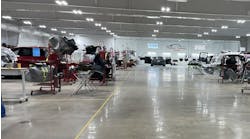MOTOR AGE GARAGE TEST 486 5/041997 Ford Explorer with clutch problems.1. Technician A says a line-up tool is absolutely necessary when installing a clutch. Technician B says a pilot bushing can be forced out of place with a carefully sized punch and some wheel bearing grease, but a special puller may be necessary to remove a pilot bearing. Who is correct?
A. Tech A
B. Tech B
C. Both
D. Neither2. Technician A says most front-wheel drive input shafts don?t use pilot bearings or bushings. Technician B says the throwout bearing on a concentric hydraulic slave cylinder will rest against the clutch release fingers at all times. Who is correct?
A. Tech A
B. Tech B
C. Both
D. Neither3. Technician A says a new clutch is likely to chatter if the flywheel isn?t resurfaced. Technician B says using too much grease to lubricate the pilot bushing or bearing can cause the clutch to chatter. Who is correct?
A. Tech A
B. Tech B
C. Both
D. Neither4. Technician A says overrevving an engine with the clutch released can cause the friction material to burst. Technician B says melted clutch release fingers can be caused by a worn transmission input shaft bearing retainer. Who is correct?
A. Tech A
B. Tech B
C. Both
D. Neither5. Technician A says front-wheel drive transverse transaxles (east-west orientation) basically receive engine torque through their cluster gear. Technician B says transaxles use hypoid gears for their ring gear and pinion. Who is correct?
A. Tech A
B. Tech B
C. Both
D. Neither6. Technician A says inner CV joints must plunge to accommodate changes in suspension geometry. Technician B says if an inner CV joint is faulty, it will always click when the wheels are turned and the vehicle is in motion. Who is correct?
A. Tech A
B. Tech B
C. Both
D. Neither7. Which of the following gear ratios would be fifth gear?
A. 2.4:1
B. 3:1
C. 0.76:1
D. 1.5:18. To calculate total gear ratio on a rear-wheel drive vehicle, you should:
A. Multiply the transmission gear ratio by the rear axle ratio.
B. Divide the differential side gear ratio by the spider gear ratio and add ring and pinion ratio.
C. Subtract rear axle ratio from transmission gear ratio.
D. None of the above.9. Helical cut gears are used in passenger car and light truck applications because:
A. They are stronger.
B. They have only two teeth in contact at all times.
C. They are easier to grind than spur gears.
D. Both A and B.10. Technician A says all manual transmissions on rear-wheel drive vehicles use at least 50-weight viscosity oil. Technician B says using gear oil that is too heavy can cause gear clash. Who is correct?
A. Tech A
B. Tech B
C. Both
D. NeitherAnswers to these test questions
will be made available online July 10, 2004.
A. Tech A
B. Tech B
C. Both
D. Neither2. Technician A says most front-wheel drive input shafts don?t use pilot bearings or bushings. Technician B says the throwout bearing on a concentric hydraulic slave cylinder will rest against the clutch release fingers at all times. Who is correct?
A. Tech A
B. Tech B
C. Both
D. Neither3. Technician A says a new clutch is likely to chatter if the flywheel isn?t resurfaced. Technician B says using too much grease to lubricate the pilot bushing or bearing can cause the clutch to chatter. Who is correct?
A. Tech A
B. Tech B
C. Both
D. Neither4. Technician A says overrevving an engine with the clutch released can cause the friction material to burst. Technician B says melted clutch release fingers can be caused by a worn transmission input shaft bearing retainer. Who is correct?
A. Tech A
B. Tech B
C. Both
D. Neither5. Technician A says front-wheel drive transverse transaxles (east-west orientation) basically receive engine torque through their cluster gear. Technician B says transaxles use hypoid gears for their ring gear and pinion. Who is correct?
A. Tech A
B. Tech B
C. Both
D. Neither6. Technician A says inner CV joints must plunge to accommodate changes in suspension geometry. Technician B says if an inner CV joint is faulty, it will always click when the wheels are turned and the vehicle is in motion. Who is correct?
A. Tech A
B. Tech B
C. Both
D. Neither7. Which of the following gear ratios would be fifth gear?
A. 2.4:1
B. 3:1
C. 0.76:1
D. 1.5:18. To calculate total gear ratio on a rear-wheel drive vehicle, you should:
A. Multiply the transmission gear ratio by the rear axle ratio.
B. Divide the differential side gear ratio by the spider gear ratio and add ring and pinion ratio.
C. Subtract rear axle ratio from transmission gear ratio.
D. None of the above.9. Helical cut gears are used in passenger car and light truck applications because:
A. They are stronger.
B. They have only two teeth in contact at all times.
C. They are easier to grind than spur gears.
D. Both A and B.10. Technician A says all manual transmissions on rear-wheel drive vehicles use at least 50-weight viscosity oil. Technician B says using gear oil that is too heavy can cause gear clash. Who is correct?
A. Tech A
B. Tech B
C. Both
D. NeitherAnswers to these test questions
will be made available online July 10, 2004.




